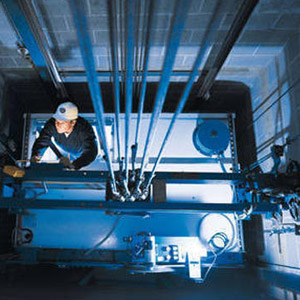What is elevator maintenance?
Elevator maintenance, is preventative maintenance on your elevator equipment. As the name indicates, the point of the maintenance is to prevent elevator callbacks, shutdowns, entrapment’s or other issues. Maintenance is designed to help reduce these issue, but not eliminate them. Most elevator companies have guided procedures to inspect, and maintain the equipment. If you have a full service maintenance agreement this should be included in your contract.
Why is elevator maintenance important?
For most buildings elevators are a central piece of your building. In fact, when most buildings are being constructed the first piece to be built is the elevator hoist way. Maintenance is important to keep costs down, keep tenants happy, prevent accidents and resulting legal costs, extend the useful life of your elevator, and to pass annual elevator inspections.
Maintenance to lower your lifetime elevator costs
When routine maintenance is performed by a trained elevator mechanic it should reduce the amount of callbacks and shutdowns that occur. This can cost you extra money in terms of additional invoices you receive for overtime mechanic visits. These overtime invoices can be thousands of dollars all for something that could have been prevented! It is also hard to budget for these types of cost which results in angry owners.
Keeping your tenants happy
40 years ago the expectation was that when you pushed the button for the elevator to come, it was ok to wait 30 – 60 seconds. In today’s world, people expect the elevator to be available almost immediately. If preventative maintenance is not performed it can lead to more elevator shutdowns. However, the human traffic remains the same meaning there is more waiting time, and complaints to the building management. Furthermore, properly maintained elevators have a smoother ride, cleaner look which almightily leads to a better elevator experience for your tenants.
Preventing accidents that result in legal woes
One of the most important jobs of an elevator provider is to ensure the safe operating of an elevator. An elevator weights over 2000 pounds and at minimum moves at least 100 feet per second. This is not something you want malfunctioning!
For example, a common type of accident that occurs to the public is misleveling of the elevator. An unmaintained elevator may stop and open the doors a few inches below the correct level causing a tripping hazard.
Another example could be a mechanic not properly maintaining the elevator doors. The elevator doors are the most used part of an elevator as the open and close each time someone uses them. If their speed is to fast, to slow or inconsistent it could knock someone over. Imagine if someone handicapped or a young child were bummed by the doors. Not only is this dangerous, but it can lead to the building owners being sued! Having preventive maintenance can help decrease these types of accidents.
Elevator Maintenance to extend the useful life of your elevator
An important item to remember is that an elevator has a normal life just like a person. If it is taken care of properly it can last longer before needing to be replaced and modernized. If the preventative maintenance is lacking, parts of the elevator will more repair effecting other parts of the elevator. Before you know it, the elevator will need a full modernization. If your elevator company can provide reliable maintenance you may be able to push out your modernization for years.
Passing annual elevator inspections
Most jurisdictions require an annual inspection by the local county/city inspector. If the elevator is written up it needs to be remedied and if not remedied the jurisdiction can shut the elevator down. If the building only has one elevator this could effectively shut down the entire building due to ADA guidelines. Preventive maintenance should help prevent any items from being written up on the inspectors report.
Examples of elevator maintenance procedures
To understand the maintenance procedures you may want to review an article and diagrams from Robson Forensic.
A preventive maintenance procedure can be as simple as a trained elevator mechanic riding the elevator. Below are some examples of items an elevator mechanic may perform.
Inside the elevator cab
- Inspect if any position indicator bulbs are burnt out
- Check for leveling accuracy to prevent tripping hazards and adjusting if necessary
- Review and adjusting door speeds if needed,
- Examine the control operating panel for any damaged buttons
- Test the emergency communication device
- Test the alarm bell
Elevator machine room
- Inspect all the machines components for leaks, excessive vibrations or wear and tear
- Inspect oil levels for hydraulic elevators
- Review machine room for cleanliness
- Inspect and replace any contacts if necessary
Elevator car top
- Inspect the car top and removing any debris if necessary
- Inspect the traveling cables for any signs of damage. Note that if there is damage this may be excluded from your elevator contract.
- Inspect the hoist way doors, hangers, door locks, and door operator
Elevator pits
- Clean any debris that has fallen in the pits
- Inspect for any flooding if necessary and alert the building managers if there are signs of water intrusion
- Ensure the stop switch is operating properly.
Preventive maintenance building engineers can perform
Most of the preventive maintenance procedures must be done by trained elevator professionals. Not only is it dangerous for untrained personal to perform this procedures, but it actually against most jurisdictions code! In no cases should a building engineer ever go into the hoist way unless they are with a trained professional. However, there are a few things building engineers can do to help with elevator maintenance.
Building engineers can do a handful of procedures in the elevator car. They can test the elevator emergency phone operations. This is tested by the elevator mechanic, and often by the local jurisdictions inspector. However, you can never be to careful when the result could be a trapped person in an elevator with no emergency personnel to call.
Engineers can also test the emergency alarm bell, and all the buttons to ensure they light up. You can save your elevator mechanic time by alerting them which buttons need to be replaced on their next visit.
Building engineers should also monitor what the elevator mechanic is working on, and the frequency of the mechanics visits. This can be found online or on a chart in the machine room.
Elevator maintenance on hydraulic vs. traction elevators
All the above elevator maintenance procedures were generic examples. Most elevator companies will perform routine maintenance 4 times per year for hydraulic elevators and 12 times per year for a traction elevator. Ideally these visits are at relatively consistent intervals.
If you feel you are not receiving the required maintenance check out this blog post for tips and tricks to ensure your getting the preventive maintenance your contract dictates.
Finally, if you still feel your maintenance is not what is should be, contact with an elevator consultant for help.
Looking for a recommendation for an elevator company or elevator consultant. Fill out the form below for help.


